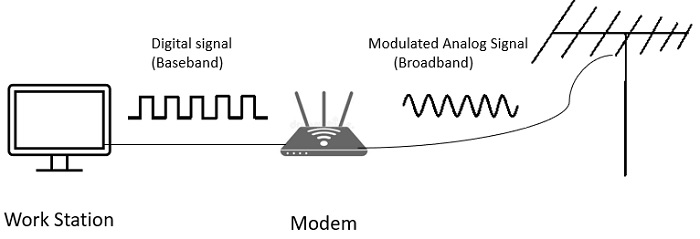
 Data Structure
Data Structure Networking
Networking RDBMS
RDBMS Operating System
Operating System Java
Java MS Excel
MS Excel iOS
iOS HTML
HTML CSS
CSS Android
Android Python
Python C Programming
C Programming C++
C++ C#
C# MongoDB
MongoDB MySQL
MySQL Javascript
Javascript PHP
PHP
- Selected Reading
- UPSC IAS Exams Notes
- Developer's Best Practices
- Questions and Answers
- Effective Resume Writing
- HR Interview Questions
- Computer Glossary
- Who is Who
What is baseband transmission in computer networks?
Digital Modulation is the process of converting between bits and signals.
Transmission Mechanisms
The various modulation schemes result in various transmission mechanisms which are as follows −
- Baseband transmission.
- Passband transmission.
Multiplexing Techniques
Sharing of a transmission channel by various signals is called multiplexing. The different multiplexing techniques are as follows −
- Time division multiplexing.
- Frequency division multiplexing.
- Code division multiplexing.
Now, let us discuss one of the digital modulation schemes.
Baseband Transmission
Baseband transmission is transmission of the encoded signal using its own baseband frequencies i.e. without any shift to higher frequency ranges. It is used for short distances.
Steps in Baseband Transmission
Let us understand the baseband transmission step by step.
Step 1 − The most straightforward form of digital modulation is to use a positive voltage which represents ‘1’ and negative voltage represents ‘0’.
Step 2 − For an optical signal the presence of light may represent ‘1’ and absence of light represent ‘0’. This scheme is called NRZ (Non-Return-to-Zero).
Step 3 − Once sent, the NRZ signal propagates down the wire.
Step 4 − At the other end, the receiver converts it into bits by sampling the signal at regular intervals of time.
Step 5 − This signal will not look exactly like the signal that was sent.
Step 6 − It will be attenuated and distorted by the channel and noise at the receiver.
Step 7 − To decode the bits, the receiver maps the signal samples to the closest symbols.
Step 8 − For NRZ, a positive voltage will be taken to indicate that ‘1’ was sent and negative voltage will be taken to indicate that ‘0’ was sent.
Step 9 − NRZ is a good starting point for studies because it is simple.
Step 10 − In practice, it is rarely used by itself.
Step 11 − More complex schemes can convert bits to signals that better meet engineering considerations.
Step 12 − These schemes are called line codes.
Step 13 − Line codes help with −
- Bandwidth efficiency.
- Clock recovery.
- DC balance.
The baseband transmission is pictorially represented as follows −


